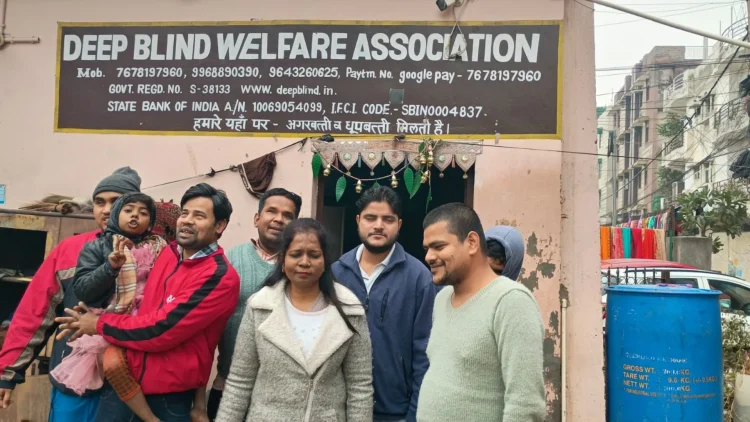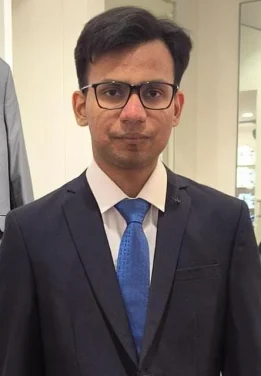Only 1 pc of visually handicapped people in India can use Braille
Braille literacy impacted by lack of trained educators & study materials

Home to nearly 15 million blind individuals India is grappling with an alarming Braille literacy crisis. Despite the growing global emphasis on inclusion and accessibility, only 1 pc of India’s blind population can read and write Braille. This shocking statistic reveals a silent yet pervasive issue that hinders millions from achieving education, employment, and independence. While technology has introduced alternatives like screen readers, Braille remains indispensable for foundational literacy and numeracy, especially in a country where digital accessibility is limited.
Mohammad Arif, a 16-year-old boy from Palasi in Araria district of Bihar, was born blind and has always dreamed of one day becoming a teacher. But for Arif, this dream feels distant, even impossible. Arif’s school has no Braille textbooks, and his teachers are not trained to help him learn the way he needs. Like many others in rural India, his education is hindered by a lack of resources and trained personnel. Without Braille, Arif cannot read a single word on his own. He often feels like an outsider, watching as his friends read and learn, while he is left to rely on the limited verbal instruction available to him.
“I have always dreamt of reading books like my friends, feeling the words on the pages, but here, there is no Braille in my school. I can’t even read a simple story on my own. I want to be a teacher, to help others like me, to show them that we can learn and do anything. But how can I teach if I can’t even read,” Arif tells Media India Group.
Arif’s dream of becoming a teacher feels like a distant hope, overshadowed by the lack of a basic education that most children take for granted.
“It is not just about learning, it is about being part of the world. If I could read and write, I would be able to help my family, my community, and others like me. But without Braille, how can we do anything,” he adds.
Arif’s story reflects the systemic challenges that visually impaired individuals across India face. There is a stark shortage of accessible Braille resources in schools, with a significant gap in the availability of Braille textbooks, Braille teachers, and technology to support independent learning. This lack of infrastructure is compounded by societal attitudes that often underestimate the abilities of the visually impaired, reinforcing the idea that people like Arif are destined to live without opportunities.
An estimated 90 pc of the world’s blind population resides in developing countries, with India home to around 15 million blind individuals, a number that has already doubled since 2007. As the second most populous nation, India accounts for a staggering one-third of the world’s blind population.
Yet, despite this significant number, the Braille literacy rate in India remains a shocking 1 pc, far lower than the country’s general literacy rate of 77.7 pc. This vast disparity underscores the deep challenges faced by the visually impaired in India. While millions of blind individuals in the country struggle to gain access to basic education and literacy, the lack of Braille resources, qualified teachers, and supportive infrastructure further exacerbates the issue.

As a result, many blind individuals, like Arif, are deprived of the opportunity to read, write, and engage with the world around them, leaving them isolated and severely limited in their future prospects. This crisis highlights the urgent need for systemic change to ensure that the visually impaired are given the tools they need to achieve equal opportunities and break free from the constraints imposed by low Braille literacy.
Nirmala Rajora, a visually impaired teacher who runs her own school for the blind in Vikaspuri, Delhi, has witnessed firsthand the obstacles that hinder the promotion of Braille literacy. Despite her efforts to create a space for visually impaired students to learn, she faces numerous challenges in providing effective education.
“Promoting Braille literacy comes with several challenges. First, there is a severe lack of resources Braille books, printers, and other essential tools are often unavailable, making it difficult to provide enough materials for my students to practice. The financial constraints are also overwhelming, as Braille-related resources are expensive and out of reach for many families, especially those from low-income backgrounds. Furthermore, many parents and communities are more focused on alternative technologies like screen readers, leading to a reduced emphasis on Braille, and learning Braille requires significant time and effort, which can discourage students when progress feels slow. These challenges are real, but it is crucial that we keep pushing for more resources and better opportunities for Braille education,” Rajora tells Media India Group.
Experts believe that Braille education plays a critical role in empowering visually impaired students, not only by enhancing their learning abilities but also by helping them integrate into society and access future opportunities.
“Braille education empowers visually impaired students by fostering independence, access to information, and greater social inclusion. To enhance Braille literacy in India, we need increased funding, teacher training, awareness campaigns, and the promotion of digital Braille technology. These steps will ensure that visually impaired students have the tools they need to succeed academically and professionally, leading to brighter future opportunities,” she adds.

In India, the lack of Qualified Teachers for the Visually Impaired (QTVIs) remains a pressing issue, and it has profound effects on the education of students with visual disabilities.
“The shortage of these teachers in India is a significant challenge, and it directly contributes to the low Braille literacy rate as many visually impaired students do not receive the quality education they deserve. As an educator, I see the consequences of this shortage every day. Without proper training in Braille, it becomes extremely difficult for my students to fully engage with the learning material, limiting their opportunities for success. This shortage is not just a logistical issue, it is a barrier to empowerment, education, and independence for visually impaired children across the country,” Rajora adds.
Organisations like the Netranjali Foundation Trust, led by Jatin Nangia, are striving to address these issues, but the path to true inclusivity remains long and complex. As President of the Foundation, Nangia is at the forefront of efforts to ensure that visually impaired individuals not only receive proper education but are also empowered to lead independent lives. However, the road ahead requires more than just good intentions, it demands collective action from all sectors of society.
“There is a severe shortage of qualified educators trained to teach Braille, which means that far too many students are left without the education they deserve. On top of that, the teaching methods used are often outdated and ineffective, limiting the reach and success of Braille literacy programmes. Accessibility in public spaces and buildings is another major barrier, with few places offering the necessary Braille signage to help visually impaired individuals navigate their surroundings. To make matters worse, the social stigma surrounding disability continues to foster negative attitudes, leading to blind individuals being underestimated in terms of their abilities. We cannot hope for change if we do not tackle these issues head-on. Addressing these challenges requires collective action from the government, educational institutions, and society at large to create an environment where the visually impaired can thrive and contribute just like anyone else,” Nangia tells Media India Group.
“Without Braille education, visually impaired individuals struggle to access educational materials, limiting their academic progress and employment opportunities. This lack of literacy forces them to depend on others for daily tasks, affecting their independence and confidence. It also leads to lower income levels and greater social isolation. Improving Braille literacy is essential for empowering the visually impaired, helping them live independently, and unlocking better opportunities for education and employment,” Nangia adds.
Manu Garg, a visually impaired student who has successfully qualified for the UPSC and is now preparing for his interview, believes that improving Braille literacy in India requires a multi-faceted approach. Drawing from his experiences and observations, he emphasises the need for systemic interventions to empower the visually impaired.

“Improving Braille literacy starts with addressing the shortage of qualified teachers. The B Ed curriculum needs to include specialised training for teaching Braille, ensuring individual-specific techniques are available. Additionally, the government should subsidise Braille resources, making them affordable and accessible. While there is significant focus on digital libraries and e-resources, we also need regular updates of Braille materials current bestsellers, newspapers, and updated study resources should be transcribed into Braille to keep students informed. Market-based interventions, like delivering Braille books through e-commerce platforms, could be a game changer, bridging the accessibility gap. These steps can transform the education landscape for visually impaired individuals in India,” Garg tells Media India Group.
“Subjects like geography and technical disciplines such as math and physics require haptic feedback through tactile plates and maps for better conceptual understanding. However, finding embossed maps or tactile learning tools is a major challenge. For someone blind since birth, grasping visual concepts like Venn diagrams becomes almost impossible without such aids. When it comes to employment, the lack of Braille has a variable impact depending on the profession. In jobs with heavy documentation or clerical requirements, offices rarely accommodate the need to convert printed materials into Braille. This forces visually impaired candidates to look for desk jobs that involve more decision-making and less paperwork. These challenges show the pressing need for more inclusive educational tools and workplace policies,” Garg adds.
“This webpage content has been taken from the Media India Group website.”
